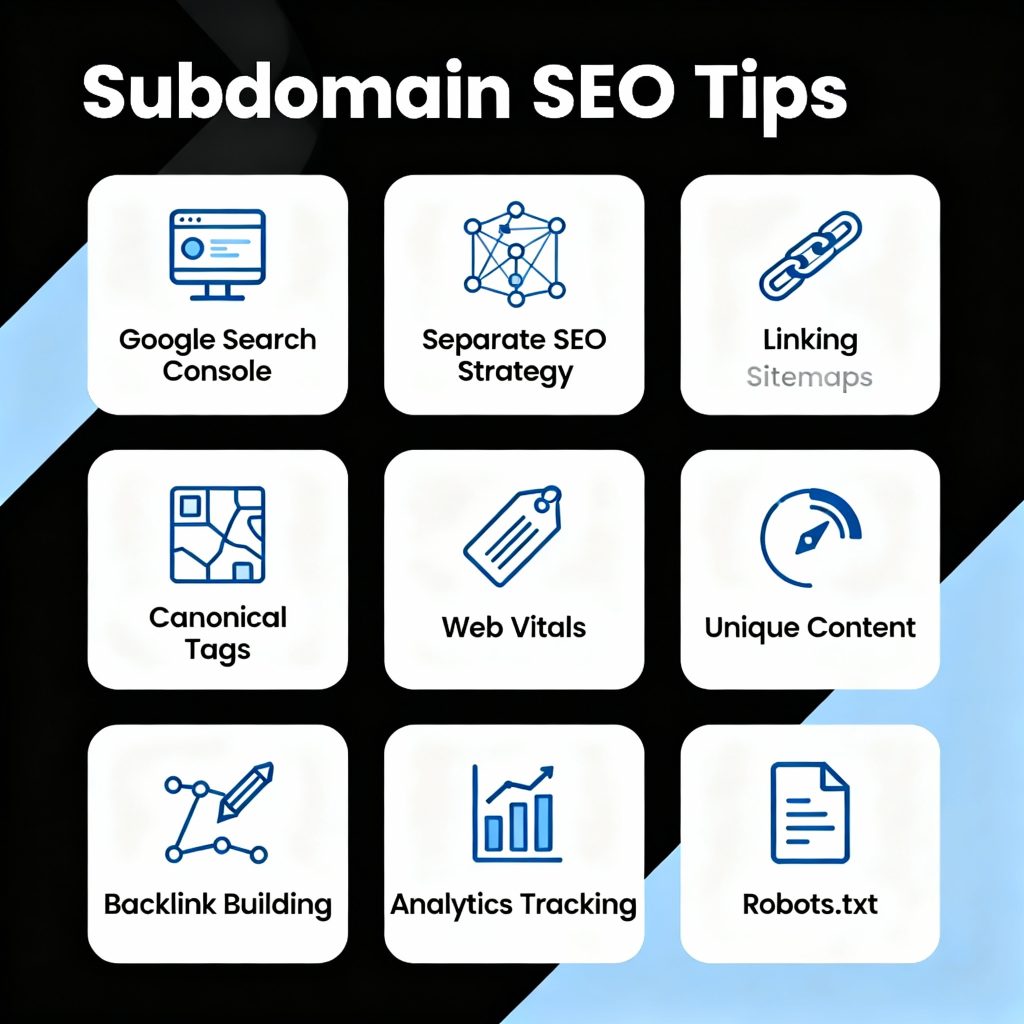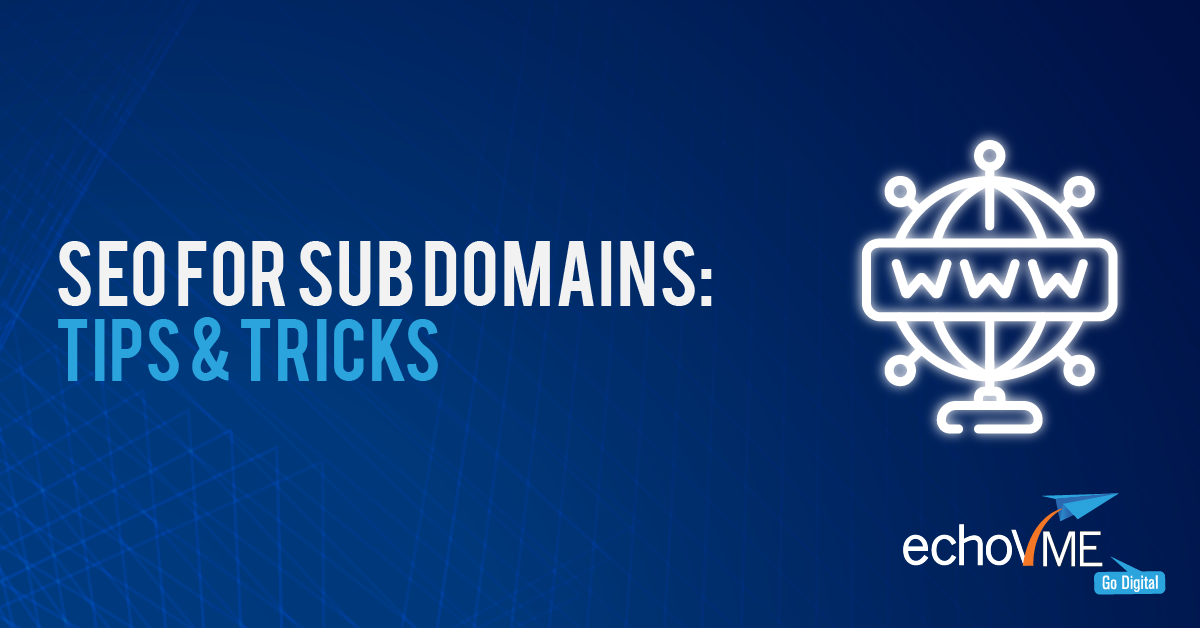Splitting your website into subdomains might seem like a technical detail – until you realise it can make or break your search performance. Whether it’s for blogs, product portals, support sections, or region-based sites, subdomains have a direct impact on how search engines crawl, index, and rank your content.
If you’re using or planning to use subdomains, SEO needs a specific approach. Here’s how to make sure each one pulls its weight.

echoVME Digital: Empowering Your Brand with 360° Marketing
Partner with echoVME Digital for full-spectrum marketing solutions — SEO, content, social, paid media, creative, and more. Drive real growth with a team that handles it all. Let’s grow your brand together!
First, What Exactly Is a Subdomain?
A subdomain is an extension of your main domain, but it operates like a separate site in the eyes of search engines. For example:
- blog.yoursite.com
- support.yoursite.com
- store.yoursite.com
These aren’t folders inside your main domain — they’re standalone properties that require separate attention in your SEO setup.
Why Subdomains Need Special SEO Attention

Search engines treat subdomains independently. So if your main site ranks well, that doesn’t automatically boost your blog or help desk subdomain.
That means:
- You need to build authority for each subdomain separately
- Each one should be optimised like its own site
- Internal linking between subdomains helps, but it isn’t a full shortcut
Skipping this step? You’ll struggle with visibility, even if your main domain is strong.
Tip 1: Set Up Google Search Console – Separately for Each Subdomain
This is a step many people miss. You need to add and verify every subdomain separately in Search Console. That’s the only way to:
- Track performance
- Monitor indexing
- Submit sitemaps
- Get issue alerts
Don’t assume your main domain’s dashboard covers it all — it doesn’t.
Tip 2: Treat Subdomains Like Independent SEO Projects
Each subdomain should have:
- Its own keyword strategy
- Dedicated content calendar
- Unique meta titles and descriptions
- Separate internal linking structure
You can reuse your overall brand tone and design, but your SEO strategy must adapt to the purpose and audience of that subdomain.
Tip 3: Interlink Your Main Domain and Subdomains Intentionally
Search engines follow links between your domain and subdomains — and that flow matters. Use strategic linking:
- From your homepage to key subdomain pages
- From blog articles to product or support portals
- In footer menus or header navigation
This helps distribute authority across your properties without confusing crawlers.
Tip 4: Submit Sitemaps Individually
Each subdomain needs its own sitemap. Submit them under the relevant property in Search Console, not under the main domain. This helps Google crawl more efficiently and avoids indexing gaps.
Make sure:
- Your sitemap follows best practices
- It’s clean, up-to-date, and reflects live content
- You resubmit after major content updates
Tip 5: Use Canonical Tags Correctly
Duplicate content across subdomains can hurt your rankings. Canonical tags help search engines understand which version to prioritise.
- For example, if you have a similar FAQ on both support.yoursite.com and www.yoursite.com, use canonical tags to avoid dilution.
Don’t rely on assumptions — review these tags periodically, especially if content overlaps.
Tip 6: Be Consistent With Core Web Vitals Across Subdomains
Google’s focus on user experience doesn’t stop at your main site. Subdomains must also meet the same technical expectations:
- Fast load speeds
- Mobile responsiveness
- Stable layout and interactivity
Run PageSpeed Insights on each subdomain separately. What passes on the main site might fail elsewhere.
Tip 7: Keep Branding Consistent, But Tailor Content
Visually, your subdomains should feel like part of the same ecosystem. But when it comes to content:
- Tailor messaging to the subdomain’s purpose
- Speak directly to the intent of users visiting that section
- Avoid copy-pasting blocks of text between sections
Search engines reward clarity and relevance — not repetition.
Tip 8: Build Backlinks to Subdomains Separately
If you’re running outreach or digital PR, don’t point everything to your homepage. Build backlinks that support the authority of each subdomain individually.
For example:
- Link to blog posts on blog.domain.com from guest articles
- Get mentions of support.domain.com from relevant directories or industry forums
Each subdomain has to earn its place in search — links help speed that up.
Tip 9: Monitor Performance With Separate Analytics Views
Set up filters or views in Google Analytics (or GA4) to track each subdomain’s traffic, engagement, and conversions. This gives you:
- Cleaner reporting
- Clearer user behaviour patterns
- Better insight into which subdomains drive value
You can’t optimise what you’re not tracking properly.
Tip 10: Review Crawl Settings in Robots.txt and Headers
Make sure none of your subdomains are accidentally blocked from being indexed. Check:
- robots.txt files per subdomain
- Meta tags like noindex on key pages
- Canonical links pointing elsewhere without context
One wrong directive can keep an entire subdomain hidden from search.
echoVME Digital: Where Strategy Meets Story
At echoVME Digital, we believe marketing is more than algorithms and ad spends. It’s about crafting stories that connect, campaigns that spark curiosity, and strategies that inspire people to take action.
Founded by Sorav Jain, one of India’s leading digital minds, we’ve grown into a full-service agency trusted by brands across industries. From social media and SEO to performance marketing, influencer outreach, and web development, we bring every piece of the digital puzzle together.
What sets us apart is our blend of creativity and clarity. With a team that lives and breathes digital, we help businesses transform clicks into conversations and engagement into growth.
At echoVME, your brand isn’t just another project. It’s a story waiting to be told—and we make sure it’s heard.
Final Thoughts
Subdomains offer flexibility — but with it comes responsibility. Each one needs its own SEO plan, technical setup, and performance strategy. When handled right, subdomains can expand your visibility, support specific audiences, and build authority across multiple verticals.
Don’t treat them as subfolders. Treat them as strategic extensions — each with their own goals, metrics, and content focus.
FAQs
1. Do subdomains help or hurt SEO?
Subdomains don’t automatically harm SEO, but they also don’t inherit ranking strength from your main domain. Each subdomain must earn authority and visibility on its own.
2. Do I need to add every subdomain to Google Search Console?
Yes. Search Console views each subdomain as separate. Adding them individually ensures you can track performance, submit sitemaps, and receive indexing alerts for each.
3. Do I need separate sitemaps for subdomains?
Yes. Each subdomain should have its own sitemap submitted under its own property in Search Console. This makes crawling more accurate and reduces the risk of missed pages.
4. How do canonical tags work across subdomains?
If content appears on more than one subdomain, canonical tags tell search engines which version is the preferred source. Without them, rankings can split between duplicates.
5. How can I build backlinks for subdomains?
Backlinks should point directly to the subdomain you want to strengthen. For example, earn links to your blog posts on blog.example.com or support content on support.example.com rather than only linking to your homepage.



